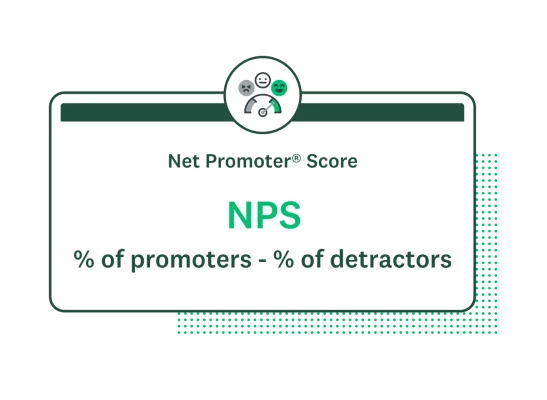Benefits of Net Promoter Score (NPS): Pros, cons, and best practices
Understand the importance of NPS and how to use it to measure and enhance customer loyalty.

Summary:
- The primary advantage of NPS is its simplicity and widespread adoption, which allows for easy benchmarking against competitors.
- A criticism is that a single number can be reductive and may not explain the complex reasons behind customer sentiment.
- It is most effective when used as part of a broader system that includes qualitative feedback and other operational metrics.
What do customers really think of your brand or products? Do they like you enough to recommend you to their friends? How likely are they to purchase from you again?
As a customer experience (CX) professional, these are crucial topics. After all, if customers aren’t satisfied with your products or services, chances are they won’t be repeat customers. Plus, recommendations matter: 54% of consumers have made a purchase based on a word-of-mouth recommendation
In this article, we’ll explore the pros and cons of NPS, best practices, and more. But first, let’s quickly define what Net Promoter Score® (NPS) is and how it can help you improve customer loyalty.
What is NPS?
NPS was established in 2003 by Fred Reichheld of Bain & Company. Its purpose is to measure customer loyalty and satisfaction in a straightforward process. Companies collect customer feedback by asking:
- “On a scale from zero to 10, how likely are you to recommend our business to a friend or colleague?”
NPS surveys determine the number of promoters, passives, and detractors a business has in its customer base. Companies around the world use this simple scoring tool to monitor customer loyalty.
Benefits of Net Promoter Score: Why is NPS important?
By regularly using NPS surveys, customer experience professionals can gain actionable insights into their audience and make informed decisions to improve customer retention.
Understanding the benefits of Net Promoter Score can help you maximize its impact. Here are 10 key advantages of NPS, starting with one of its biggest strengths, its simplicity.
1. Simple and easy to use
One of the key advantages of NPS is its simplicity. Net Promoter Score (NPS) provides a straightforward way to track progress and measure customer sentiment with a single question. It is easy to create, send, and understand the survey results.
Additionally, NPS data analysis is straightforward, and the results can be used to identify areas for improvement and track progress over time.
Luckily, the calculation formula is intuitive and only requires a basic spreadsheet. Or, if you use the SurveyMonkey NPS template, we’ll handle the math for you!
2. Predicts business growth
A high NPS score correlates with customer retention and helps predict revenue growth. Businesses can use insights from NPS surveys to see their direction. A good NPS score signals that there are many advocates for a business, indicating repeat business and word-of-mouth referrals.
3. Benchmarking against competitors
Since the Net Promoter Score is used by companies worldwide, businesses can quickly benchmark their NPS and compare it to industry standards.
For example, in your industry, the average NPS could be 68. If your business scores 55, it shows you have work to do to stand against competitors. Take the reverse of that and say the industry average NPS is 55. If your NPS score is 68, it shows customers are highly satisfied with your brand compared to others in the industry.
4. Helps identify advocates
Companies can use NPS surveys to identify which customers are brand promoters. Businesses can leverage happy customers for word-of-mouth marketing. This free advertising is extremely important to a brand’s growth strategy. Word-of-mouth marketing offers benefits to businesses, such as:
- Boosting brand loyalty
- Improving brand reputation
- Decreasing customer acquisition costs (CAC)
5. Encourages continuous improvement
Net Promoter Score surveys are based on a single question, but businesses often add several follow-up questions. Follow-up questions in an NPS survey should be open-ended to allow customers to share specific feedback. Customer feedback, especially from detractors, helps businesses identify areas for improvement.
Learn how Tweezerman uses SurveyMonkey to keep tabs on its brand health and NPS and identify new business opportunities.
6. Identifies customer segments
This type of survey also helps businesses distinguish customer segments for targeted improvements. In addition to categorizing customers as promoters, passives, and detractors, you can segment the data by demographics. Segmenting data based on customers’ ages, locations, purchase histories, etc., gives you more comprehensive insights.
7. Helps implement targeted strategies
After identifying customer segments, businesses can apply targeted strategies. For example, NPS data could reveal that most of your business's detractors identify as male. Your marketing and product teams can dig into the qualitative data to find other patterns among detractors and make targeted improvements.
8. Tracks changes over time
By tracking NPS on a rolling basis, organizations can monitor customer loyalty and satisfaction changes. Tracking improvements and declines enables businesses to see how decisions impact customers.
9. Strengthens customer relationships
Net Promoter Score also helps build better customer relationships by displaying your business’s customer-centric nature. Customers want to be heard, and sending NPS surveys shows that you want to listen to their feedback.
For example, a company might use customer support chat to trigger an NPS survey right after resolving an issue, capturing real-time feedback on the service experience.
10. Provides actionable insights
NPS scores provide actionable insights that pinpoint areas for business growth. For example, the data may show dissatisfaction with a certain product or demographic. Teams can investigate the lower score to determine ways to improve the product.
Drawbacks of Net Promoter Score
There are two sides to every coin. Net Promoter Score isn’t a perfect solution for all businesses. While there are many benefits, there are disadvantages of NPS to be aware of, including:
1. Lacks the “why” behind the score

The standard NPS question provides a valuable high-level view of customer sentiment. However, to fully understand the “why” behind the scores, it’s beneficial to include open-ended follow-up questions or pair NPS with other customer feedback KPIs.
2. Cultural and industry variations
NPS benchmarks can vary widely across industries and regions due to differing customer expectations. SurveyMonkey research shows that average Net Promoter Scores are highest in Brazil and lowest in Japan. These variations are due to cultural and expectation differences in individual countries. Quality and ease of use were cited as top drivers for respondents in the US, Canada, Brazil, and other countries.

3. NPS is one piece of the CX puzzle
While NPS is a valuable metric, it represents just one piece of the customer experience puzzle. A single score may not capture the full journey, so it’s important to incorporate other metrics such as Customer Satisfaction Score (CSAT), Customer Effort Score (CES), and customer journey mapping for a well-rounded approach.
4. Response bias
Highly engaged customers—both enthusiastic promoters and dissatisfied detractors—are often the most likely to respond to NPS surveys, which can lead to response bias. To mitigate this, businesses can encourage a broader range of customers to participate by optimizing survey timing, personalizing outreach, and keeping surveys short and engaging.
5. Doesn’t address passives
Neutral respondents (scoring 7-8) don’t directly impact the NPS calculation, but they represent a crucial segment that may still churn. Businesses can use additional surveys or customer outreach efforts to better understand and engage this group.
6. NPS must be combined with other metrics
Teams may get too caught up in Net Promoter Score and ignore other key customer experience metrics. Companies also gather valuable feedback from other surveys, which shouldn’t be overlooked.
7. Inadequate context
NPS helps you understand customer loyalty, but it is essential to follow up with more specific market research or customer satisfaction surveys. Sending NPS surveys is a good first step, but a follow-up plan provides the necessary context.
8. Can be subjective
Net Promoter Score asks about the likelihood of a customer recommending a brand or product with their peers. Some customers don’t recommend any brands or products to others, even if they like them. The core NPS question may not apply to some respondents, causing them to score lower.
When to use NPS and when to consider alternatives
You may wonder when Net Promoter Score is appropriate for your business. While your company could measure many other metrics, such as CSAT or CES, there are certain scenarios in which NPS is the most effective metric to analyze.
When to use NPS
- Track long-term customer loyalty
- Benchmark performance against competitors
- Identify and leverage brand advocates
- Track customer satisfaction over time to identify trends and make informed decisions
When to consider alternatives
It’s best practice to use NPS in tandem with other leading loyalty metrics to contribute to a successful Voice of the Customer (VoC) program. Here are some other Net Promoter Score alternatives you can use to measure customer pain points, loyalty, and satisfaction.
Need detailed customer feedback? Use open-ended survey questions.
Open-ended survey questions allow customers to leave detailed responses that help pinpoint specific issues. NPS focuses more on scoring and tracking customer experiences over time. We always recommend adding open-ended questions to NPS surveys to capture more actionable insights.
Evaluating specific interactions or overall satisfaction? Consider CSAT.
CSAT measures how satisfied customers are with a specific service, product, or interaction. It’s a powerful tool for capturing real-time feedback and understanding in-the-moment customer sentiment.
The core CSAT question typically asks:
- "How satisfied were you with [specific experience, product, or service]?"
Customers respond on a scale, often from 1 (Very dissatisfied) to 5 (Very satisfied).
By leveraging CSAT, businesses can:
- Improve customer satisfaction
- Optimize customer touchpoints
- Identify and resolve poor customer experiences
- Eliminate friction in the customer journey
- Boost revenue and reduce churn
Learn more about Customer Satisfaction Score by reading our ultimate guide or creating a survey using our Customer Satisfaction Survey Template.
Looking to uncover customer friction or pain points? Use Customer Effort Score.
Customer Effort Score measures the effort customers put into a specific interaction, such as making a purchase or resolving an issue via a support chat. High-effort experiences—like long wait times or complex checkouts—can frustrate customers and drive churn. CES data helps businesses identify and eliminate these friction points.
The core CES question typically asks:
- "How easy was it to [complete a specific action]?"
This is often presented as a statement for customers to rate on a scale, such as:
- "To what extent do you agree with the following statement: [The company] made it easy for me to resolve my issue."
Customers respond using a scale, typically ranging from 1 (Strongly disagree) to 7 (Strongly agree), though some variations use a 5- or 10-point scale. A higher score indicates a smoother, lower-effort experience, while a lower score signals potential pain points that businesses need to address.
Get started with a free Customer Effort Score survey template.
Have a complex customer journey? Use multiple feedback mechanisms.
For complex customer journeys, you may need to use multiple feedback vehicles. Many companies track NPS, CES, and CSAT to glean comprehensive insights.
Low survey response rates? Explore alternative engagement strategies.
If your NPS surveys aren’t getting many responses, you might want to try other engagement strategies. Customer engagement strategies include offering personalized experiences, sending reminders, tailoring survey content, and optimizing for mobile use.
Looking to uncover employee engagement and satisfaction? Use eNPS.
In addition to customer feedback, businesses can use the employee Net Promoter Score (eNPS) to gather insights on employee satisfaction.
How to calculate Net Promoter Score
One of the best parts of Net Promoter Score is how simple it is to calculate. We’ll outline the process and include an example.

Step 1: Categorize respondents
Respondents should be separated into three categories based on their rating on the Likert scale.
- Promoters (responded 9-10)
- Passives (responded 7-8)
- Detractors (responded 0-6)
Step 2: Apply the formula
Once you’ve categorized respondents, apply the formula below to calculate NPS.
- NPS = (% promoters - % detractors)
NPS calculation example:
A company sent its customers an NPS survey. It received 200 responses in total. There were 140 promoters, 40 passives, and 20 detractors. To apply the formula, we will take the percentage of promoters (70%) and subtract the percentage of detractors (10%).
- 70% - 10% = 60 NPS
Check out the complete guide on how to calculate Net Promoter Score.
NPS calculator and template
While calculating NPS for 200 respondents is quite simple, the calculation becomes more complex with a larger survey. Streamline your NPS analysis with our NPS calculator. Skip the spreadsheets and manual calculations. Input your data and get instant results.
To make it even easier, use our NPS survey template; we will automatically calculate your score!
What is a good Net Promoter Score?
There is no true standard for a “good” Net Promoter Score as it varies greatly by industry. In general, most industries can use this as a guide:
- Excellent NPS: 50+
- Good NPS: 30-49
- Average NPS: 0-29
- Poor NPS: Below 0
Benchmarking against other companies in your industry is best to see where your business stands. For example, the industry average NPS for insurance companies is much higher (71) than for healthcare (38).
See more industry benchmarks in our article, What is a good Net Promoter Score (NPS)?
Comparing short-term and long-term NPS
NPS can be used to measure customer loyalty and satisfaction over the short or long term.
- Short-term NPS measures customer sentiment and loyalty following a specific interaction.
- Long-term NPS is more holistic and measures customers' likelihood to recommend your business over time.
Transactional NPS vs. relational NPS
Transactional NPS (tNPS) is designed to capture quick customer feedback after a specific interaction. tNPS is often used to gather insights into customers' feelings after purchasing a product, ending a support call, or engaging in other service interactions.
Relational NPS (rNPS) is a broader measurement of customer loyalty that evaluates long-term customer relationships. It helps businesses track customer loyalty trends over time and build lasting relationships. rNPS surveys are typically conducted quarterly or annually to glean strategic insights year over year.
Further reading: Transactional vs. relational NPS
Using SurveyMonkey as your NPS survey platform
If you want to accurately measure customer loyalty and brand perception, SurveyMonkey can help. Our feedback management platform features an easy setup and hundreds of customizable survey templates.
Built-in analytics enable businesses to track NPS and identify trends effectively. SurveyMonkey also integrates with CRM and marketing automation tools for seamless workflow management.
Start conducting NPS surveys today with the Net Promoter Score Survey Template.
Net Promoter, Net Promoter Score, and NPS are trademarks of Satmetrix Systems, Inc., Bain & Company, Inc., and Fred Reichheld.
See how SurveyMonkey can power your curiosity
Net Promoter, Net Promoter Score, and NPS are trademarks of Satmetrix Systems, Inc., Bain & Company, Inc., and Fred Reichheld.
Discover more resources

Solutions for your role
SurveyMonkey can help you do your job better. Discover how to make a bigger impact with winning strategies, products, experiences, and more.

Why are surveys important in research?
Surveys are important in research because they offer a flexible and dependable method of gathering crucial data. Learn more today.

NPS surveys: Best practices for high response rates
Learn NPS survey best practices to drive high response rates by improving survey processes.

23 ways to increase CSAT response rates
It's hard to improve your customer satisfaction scores without respondents. Get SurveyMonkey's best actionable tips to improve your response rate.